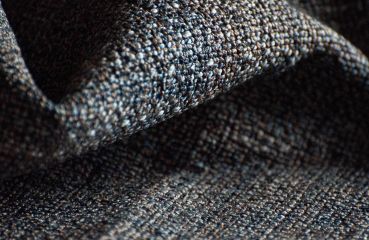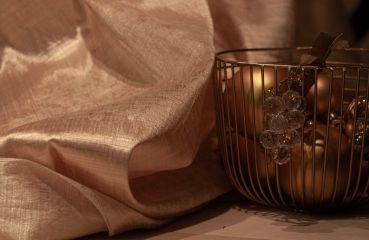ABOUT the fabric on the wall
The history of wall fabrics. Tapisser or cover something with a fabric.
Fabrics have accompanied us for a very long time, serving numerous functions from the very beginning – from purely utilitarian, through sacral, to decorative. Braids made from grasses and other plants were the most likely prototypes of fabrics. Researchers trace back the origins of linen fabric to ancient Egypt.
One of the oldest techniques in patterned weaving is the kilim technique. It has been known since antiquity, when nomadic tribes used it to decorate walls and floors, and to cover furniture. In Europe, the kilim became widespread in the early Middle Ages, and the custom of decorating walls with it has survived to the present day. The same is true of one-sided, ornamental carpets of eastern origin, which at the beginning were used primarily as wall decoration.

Sometimes the term “oriental carpet” is used to denote a richly decorated rug. To this day, the basic raw materials used in the process of weaving carpets are natural cotton, wool or silk yarns, and rarely artificial fibres. The fabric is made of a warp and two wefts. One is a thin binder weft which, interwoven with the warp in a plain weave, forms the load-bearing structure of the carpet. The second thread, thicker, introduced with short sections in the form of knots, creates a pattern.
The most exclusive silk carpets, which are richly embroidered or decorated with appliqué, and trimmed with gold or silver, are also referred to by the term tapestry (however, in Polish a loanword makata derived from Arabic Mak ad – cover or seat is used). Unlike the geometric decorations of kilims, tapestries were often covered with floral or architectural patterns. In the countries of the Middle East, they were hung on the walls of houses and in tents (the so-called tent tapestries) or covered furniture.
The terminology of wall fabrics is varied and to a certain extent ruled by conventions. Arras tapestries are textiles made in the 15th and 16th centuries. The term “Arras” comes from the French town of that name. In the 14th and 15th centuries, Arras was the main weaving centre that produced the famous, richly decorated fabrics, which then found their way to the walls of the residences of the wealthiest families. They often measured several metres in length and width.
Wool-woven weft was frequently decorated with silk, as well as silver or gold threads. That is why Arras tapestry often refers to the most sophisticated and magnificent fabrics. The city of Arras was hit by plague and famine in the middle of the 15th century, and these elaborate fabrics began to be produced in other places, but the name survived in common use until the end of the 16th century.

Those made later, in a slightly more modest style, are usually referred to as Gobelin tapestries. They originated in the 17th century, when the king of France, Louis XIV, founded the royal Gobelins Manufactory in areas bought from the weaving family of Gobelins who produced wall fabrics. The subsequent industrial revolution enabled the process of mechanization of weaving tapestries, which significantly reduced production costs, so that more and more people could afford this type of interior decoration.
However, the most general name that has been adopted as a term for all fabrics adorning our walls is tapestry. The name comes from the Old French word tapisser , which means more or less “to cover something with cloth”. It was used in the context of both Arras and Gobelin tapestries, gradually taking the place of both in speech and writing. Later on, they were displayed on walls, especially by the collectors of oriental carpets, due to the lack of space and their desire to keep them intact, but this practice did not change the names.
Weft and warp instead of paints and chisels.
For centuries, fabrics have2 also been used in art as a painting base. Over time, the basic medium of weft and warp weave has become a tool of artistic expression, depicting and building narratives, filling space or creating installations with fabric.
A decorative fabric, also known as an artistic fabric, has artistic and decorative value as it has been made by an artist or according to his or her design. Textile projects in the field of artistic fabrics are carried out in various traditional techniques such as tapestry, rug, batik, macrame or felting, but they also present numerous modern variations on the theme. The group of artistic fabrics also includes folk striped textiles, rugs, etc.

These fabrics are usually produced by hand in simple, wooden weaving workshops, or on wooden frames with a special comb or a heavy fork. The raw material for making such fabrics is linen or hemp yarn for the warp and very thick wool yarn for the weft.
The weft materials also include fabric clippings, furs, grass stalks, straw, reeds, bamboo shoots, and even thin wooden slats or other materials – as intended by the creator. The most commonly used weaves in these fabrics are plain or twill weaves.
Artistic textiles gained a prestigious status after the Second World War – especially in Poland and Japan. The most famous exhibition of artistic fabrics in Poland is the International Triennial of Tapestry in Łódź at the Central Museum of Textiles. The Lausanne Biennale of Artistic Textiles is an internationally renowned event.
Polish phenomenon. Textile experiments in the People's Republic of Poland.
The 60s of the previous century were a golden period in the history of Polish art, in which a textile, a medium considered to be utilitarian, gained independence. It was then that the phenomenon known as the "Polish school of textile art" crystallized. Several factors contributed to its uniqueness and popularity – the long tradition of decorative textiles, the development of artistic education in the field of textiles at Polish universities and finally the international renaissance of artistic textiles. It was definitely a time when fabric design was catching up with painting and sculpture.

Polish artists, led by Magdalena Abakanowicz, thought with weaves, designed directly on a loom, used the character of weaves, created relief compositions, and experimented with materials. Consequently, the new textile could follow the latest trends in painting – it was called “structural” for a reason. The somewhat amusing term “soft sculpture” was coined at that time.
In the 1960s, Abakanowicz gradually made her fabrics independent of the wall and gave them a personal mark, calling them “Abakans”. To this day, Abakanowicz is one of the few Polish artists whose name is known to every Pole. The boom for artistic textiles continued in the 1970s, but then a rapid decline followed. Today, its status is similar to printmaking, which is somewhat a bygone technique.

Art not always with a capital “A” or DIY modernity.
There are currently multiple alternative approaches which, in line with the trend for good craftsmanship and handicraft return, promote the use of fabrics in the form of decorative upholstered panels, or contemporary tapestries, kilims, etc. in interior design. After all, to this day fabrics in interiors can play not only a utilitarian role, but also a decorative one, filling the space with colours, textures, various jacquard patterns or prints.

With soft lines of organic patterns or contrasting, intriguing geometry, they complement the architecture, just like prints or posters. Their additional advantages are a pleasant texture, which allows the play of light and shade, as well as anti-acoustic qualities. The range of decorative fabrics available on the market offers an enormous range of possibilities, each time limited only by the boundaries of our own imagination.


Fabrics from the Dekoma collection featured in the session:
Cholet is an impressive decorative fabric with a soft texture and a large geometric pattern of irregular triangles contrasting with the grey background. The product is available in three colour variants with different accents of green, azure and black. Cholet is an interesting solution for enthusists of unique design, perfectly suited for screens, blinds, roller blinds and cushions. Certified with OEKO-TEX® Standard 100, the fabric is safe for the environment and human health.
Thick upholstery fabric with a modern geometric pattern of hexagons in four colour variants: muted greys, black and white, grey with pastel or saturated pink and grey with blue, turquoise and navy blue. With its good technical parameters (20 000 Martindale cycles), this high-quality blend of viscose and polyester is mainly recommended for household interiors. It is a great choice for modern-style interiors or children's and teen rooms.
Pictor is a spectacular, elegant decorative and furniture fabric, whose technical parameters make it suitable for upholstery in household furniture. It has a large, black herringbone pattern on a matte background. The fabric comes in three colour sets (grey, black, red) and may be combined with other fabrics from the Pictor collection. It is perfectly suited for Scandinavian, vintage, modern and minimalist interiors.
Virgo is a spectacular, elegant decorative and furniture fabric, whose technical parameters make it suitable for upholstery in household furniture. It has a large, graphic pattern on a matte background. The fabric comes in three colour sets (grey, black, red) and may be combined with other fabrics from the Pictor collection. It is perfectly suited for Scandinavian, vintage, modern and minimalist interiors.
Photo-session for Dekoma.
Creative idea, text, photographs and styling MBBM Studio.










































